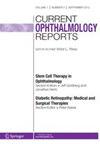经眼睑血压计是角膜病理学中眼压监测的首选方法
IF 0.8
Q4 OPHTHALMOLOGY
引用次数: 0
摘要
背景:在合并眼部疾病的情况下测量眼压可以决定进一步的治疗和预后。然而,眼压测量在角膜疾病中可能导致不可靠的结果。在这些环境中寻找测量眼压的方法是扩大诊断能力的关键任务。目的:评价经睑压测量对各种角膜病变患者眼压监测的诊断价值。材料和方法:对39例青光眼和/或白内障患者(平均年龄62.34 - 9.1岁)进行眼压测量,这些患者的角膜因各种眼病发生变化:创伤后疤痕;屈光手术造成的角膜切开术疤痕;各种病因引起的溃疡性角膜缺损;角膜侵蚀;大疱的角膜病;翼状胬肉手术治疗后的畸形和白血病或接触传染因子。眼压测量采用触诊法、反跳法和经睑压法,部分病例采用Maklakov法。结果:平均数据具有可比性:触诊;回弹血压计23.34 4.7 mm Hg;经颅血压计24.27 4.7 mm Hg;随着血压计使用技能的提高,测量结果的准确性和重复性显著提高。结论:使用TVGD-02眼压计进行经睑压测量可以充分评估角膜病变患者的眼压。在技术实施过程中没有接触,使得在测量某些类别的患者眼压时可以将其视为优先事项。本文章由计算机程序翻译,如有差异,请以英文原文为准。
Transpalpebral tonometry as a priority method for intraocular pressure monitoring in corneal pathology
BACKGROUND: Measurement of intraocular pressure in the presence of combined ophthalmic condition could determine further therapy and prognosis. However, tonometry in corneal diseases could lead to unreliable results. The search for methods for intraocular pressure measurement in these settings is a critical task intended to expand diagnostic capabilities.
AIM: Evaluation of the transpalpebral tonometry diagnostic value for intraocular pressure monitoring in patients with corneal conditions of various origin.
MATERIALS AND METHODS: Measurements of intraocular pressure were carried out in 39 patients with glaucoma and/or cataract (mean age 62.34 9.1), with corneal changes due to various ophthalmic conditions: post-traumatic scars; keratotomy scars as a result of refractive surgery; corneal defects due to ulcerative process of various etiology; corneal erosions; bullous keratopathy; deformities and leukomas after surgical treatment of pterygium or exposure to an infectious agent. Intraocular pressure measurement was carried out using several methods: palpation, using rebound and transpalpebral tonometry, in some cases tonometry was performed according to Maklakov method.
RESULTS: The averaged data were comparable: palpation; rebound tonometry 23.34 4.7 mm Hg; transpalpebral tonometry 24.27 4.7 mm Hg; and Maklakov tonometry 23.16 5.4 mm Hg. The accuracy and reproducibility of measurement results increased significantly with the improvement of skills in using tonometers.
CONCLUSIONS: Transpalpebral tonometry using TVGD-02 tonometer makes it possible to adequately assess intraocular pressure in patients with corneal pathology. The absence of contact during the implementation of technique makes it possible to recognize it as a priority when measuring intraocular pressure in certain categories of patients.
求助全文
通过发布文献求助,成功后即可免费获取论文全文。
去求助
来源期刊

Current Ophthalmology Reports
Medicine-Ophthalmology
CiteScore
2.00
自引率
0.00%
发文量
22
期刊介绍:
This journal aims to offer expert review articles on the most significant recent developments in the field of ophthalmology. By providing clear, insightful, balanced contributions, the journal intends to serve those who diagnose, treat, manage, and prevent ocular conditions and diseases. We accomplish this aim by appointing international authorities to serve as Section Editors in key subject areas across the field. Section Editors select topics for which leading experts contribute comprehensive review articles that emphasize new developments and recently published papers of major importance, highlighted by annotated reference lists. An Editorial Board of more than 20 internationally diverse members reviews the annual table of contents, ensures that topics include emerging research, and suggests topics of special importance to their country/region. Topics covered may include age-related macular degeneration; diabetic retinopathy; dry eye syndrome; glaucoma; pediatric ophthalmology; ocular infections; refractive surgery; and stem cell therapy.
 求助内容:
求助内容: 应助结果提醒方式:
应助结果提醒方式:


